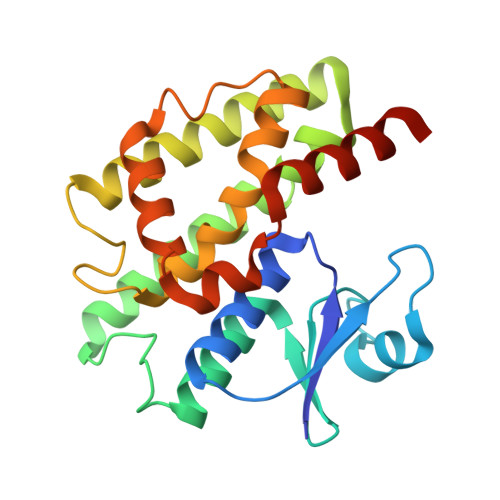Disulfide bond formation protects Arabidopsis thaliana glutathione transferase tau 23 from oxidative damage.
Tossounian, M.A., Van Molle, I., Wahni, K., Jacques, S., Gevaert, K., Van Breusegem, F., Vertommen, D., Young, D., Rosado, L.A., Messens, J.(2018) Biochim Biophys Acta 1862: 775-789
- PubMed: 29031766
- DOI: https://doi.org/10.1016/j.bbagen.2017.10.007
- Primary Citation of Related Structures:
5O84, 6EP6, 6EP7 - PubMed Abstract:
Glutathione transferases play an important role as detoxifying enzymes. In A. thaliana, elevated levels of reactive oxygen species (ROS), provoked during biotic and abiotic stress, influence the activity of GSTU23. The aim of this study is to determine the impact of oxidative stress on the function and structure of GSTU23. The impact of oxidation on the function of GSTU23 was studied using a glutathione transferase biochemical assay and mass spectrometry. With kinetics, circular dichroism and thermodynamics, we compared reduced with oxidized GSTU23. X-ray crystal structures of GSTU23 visualize the impact of oxidation on methionines and cysteines. In the presence of 100μM H 2 O 2 , oxidation of the methionine side-chain to a sulfoxide is the prominent post-translational modification, which can be reduced by C. diphtheriae MsrA and MsrB. However, increasing the level to 200μM H 2 O 2 results in a reversible intramolecular disulfide between Cys65-Cys110, which is substrate for glutaredoxin. Under these oxidizing conditions, GSTU23 undergoes a structural change and forms a more favourable enzyme-substrate complex to overcome k cat decrease. At lower H 2 O 2 levels (100μM), GSTU23 forms methionine sulfoxides. Specifically, oxidation of Met14, located near the catalytic Ser13, could interfere with both GSH binding and catalytic activation. At higher H 2 O 2 levels (200μM), the Cys65-Cys110 disulfide bond protects other cysteines and also methionines from overoxidation. This study shows the impact of oxidative stress on GSTU23 regulated by methionine sulfoxide reductases and glutaredoxin, and the mechanisms involved in maintaining its catalytic functionality under oxidizing conditions.
Organizational Affiliation:
VIB-VUB Center for Structural Biology, B-1050 Brussels, Belgium; Brussels Center for Redox Biology, B-1050 Brussels, Belgium; Structural Biology Brussels, Vrije Universiteit Brussel, B-1050 Brussels, Belgium.
















